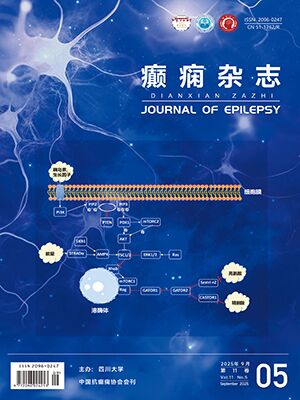| 1. |
中国抗癫痫协会. 临床诊疗指南: 癫痫病分册. 北京: 人民卫生出版社, 2023.
|
| 2. |
Song L, Liu F, Liu Y, et al. Clonazepam add-on therapy for refractory epilepsy in adults and children. Cochrane Database Syst Rev, 2018, 5(5): CD01 2253.
|
| 3. |
张宇昕, 翟琼香, 汤志鸿, 等. 左乙拉西坦添加治疗小儿额叶癫痫: 附 105 例报告. 南方医科大学学报, 2014, 34(3): 364-367.
|
| 4. |
郑筱萸. 中药新药临床研究指导原则: 试行. 北京: 中国医药科技出版社, 2002.
|
| 5. |
马融, 李新民, 张德芹, 等. 小儿抗痫胶囊治疗儿童癫痫及其神经生化机制的研究. 医学研究杂 志, 2 006, 35(9): 39-40.
|
| 6. |
钱悠悠. 拉莫三嗪联合小剂量丙戊酸钠治疗初诊癫痫的疗效及对神经认知功能的影响. 实用临床医药杂志, 2020, 24(2): 80-82,86.
|
| 7. |
Rigo JM, Hans G, Nguyen L, et al. The anti-epileptic drug levetiracetam reverses the inhibition by negative allosteric modulators of neuronal GABA- and glycine-gated currents. BriT J Pharmacol, 2002, 136(5): 659-672.
|
| 8. |
Preuss RGWT. OxcarbazepineIn: Stat Pearls. Treasure Island (FL): StatPearls Publishing, 2022.
|
| 9. |
彭梦婕, 邹建华. Development of overseas Chinese medicine and legislative status. World Journal of Integrated Traditional and Western Medicine, 2022, 5(6): 24-33.
|
| 10. |
孙秋玲, 申兴田, 董争清, 等. 小儿抗痫胶囊联合左乙拉西坦治疗小儿癫痫伴智力低下疗效及血清瘦素、白细胞介素6和胰岛素样生长因子1的影响. 实验与检验医学, 2019, 37(5): 944-947.
|
| 11. |
卢俞任, 毛中臣. 小儿抗痫胶囊联合奥卡西平治疗小儿癫痫的疗效观察. 药物评价研究, 2020, 43(2): 277-282.
|
| 12. |
耿丽娟, 王葆辉, 张现娥, 等. 小儿抗痫胶囊联合丙戊酸钠治疗儿童原发性全身强直– 阵挛发作型癫痫的临床研究及其对GFAP、S100β水平的影响. 现代药物与临床, 2021, 36(5): 995-999.
|
| 13. |
郭娜, 马英, 王琳莹, 等. 脑卒中患者血清 Hcy及NSE水平与癫痫发作的相关性研究. 现代检验医学杂志, 2022, 37(1): 177-181.
|
| 14. |
黎素清, 郑凤丽, 谭志军, 等. 癫痫患儿血清及脑脊液 CRP、S100β、NSE 含量变化与临床意义. 现代医学与健康研究, 2020, 4(5): 84-85.
|
| 15. |
ZhaoYL , Li JM, Fan Y, et al. Sodium valproate combined with levetiracetam in pediatric epilepsy and its influence on NSE, IL6, hsCRP and electroencephalogram improvement. Experimental And Therapeutic Medicine, 2020, 20: 2043-2048.
|
| 16. |
Mu RZ, Liu S, Liang KG, et al. A meta-analysis of neuron-specifific enolase levels in cerebrospinal fluid and serum in children with epilepsy. Front Mol Neurosci, 2020, 10(13): 24.
|
| 17. |
Hanak TJ, Libbey JE, Doty DJ, et al. Positive modulation of m GluR5 attenuates seizures and reduces TNF-a+macrophages and microglia in the brain in a murine model of virus-induced temporal lobe epilepsy. Exp l Neuro1, 2019, 311: 194-204.
|
| 18. |
黄永洪, 康颖, 韩登科, 等. 125例癫痫患儿外周血B淋巴细胞、NK 细胞和NKT 细胞的检测与分析. 国际检验医学杂志, 2017, 38(27): 3286-3290.
|
| 19. |
黎雪萍, 陈志红. 小儿癫痫外周血淋巴细胞亚群水平的变化及其意义. 汕头大学医学院, 硕士学位论文, 2022.
|




